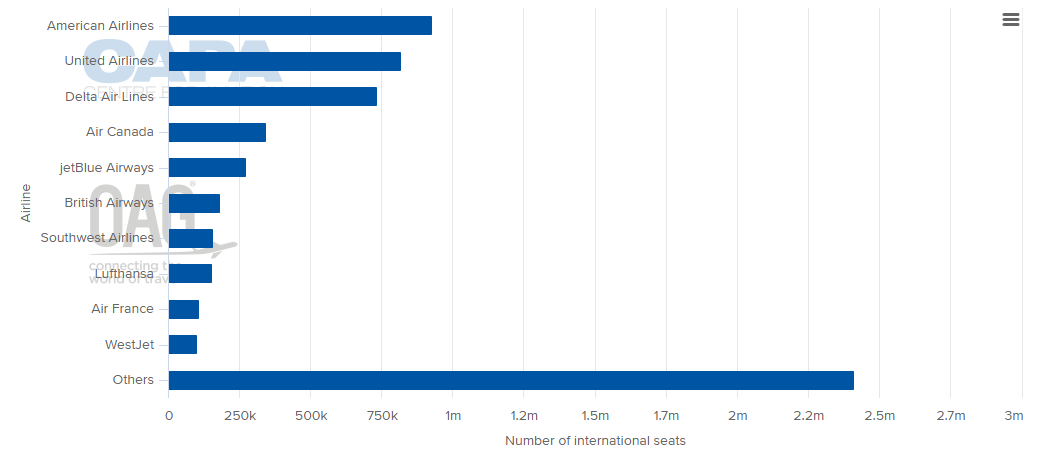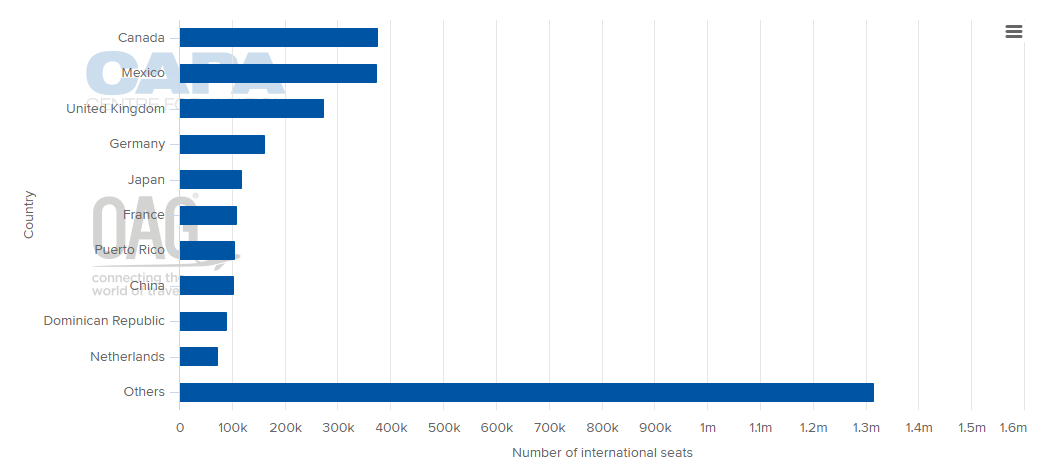In a process that will raise the global baseline of aviation security, DHS is calling for additional seen and unseen checks, at all last-point-of-departure airports in 105 countries around world to be implemented in phases. While airports with non-stop flights to the USA have been gearing up for increased security requirements, the revised policy could influence changes across the industry and see airlines take additional responsibility for their passengers.
Obviously the details of the change remain sketchy but will include, but are not limited to enhanced overall passenger screening; heightened screening of personal electronic devices; increasing security protocols around aircraft and in passenger areas; and deploying advanced technology, expanding canine screening, and establishing additional preclearance locations.
CHART - Largest International Airlines Serving the United States of America (weekly seats) Source: CAPA - Centre for Aviation and OAG Schedules Analyser
Source: CAPA - Centre for Aviation and OAG Schedules Analyser
The enhanced aviation security enhancements will be implemented in phases over the next several weeks and months. While some will be required immediately, other measures will be implemented over time, in coordination with international partners. US officials say stakeholders who fail to implement these requirements and the follow-on measures within certain timeframes run the risk of "additional security restrictions". Ultimately, failure to follow security directives "can jeopardise an airline or airport's ability to operate flights into the US," it adds.
The new security requirements will enable the lifting of the current large personal electronic device ban in place at ten airports with direct flights to the US once it is proved they comply with the new rules. In fact United Arab Emirates (UAE) operator Etihad Airways has already confirmed that its Abu Dhabi International Airport hub already satisfies the short-term measures required by the Transportation Security Administration (TSA) thanks to the superior security advantages provided by its preclearance facility and that the electronic devices ban has already been lifted.
"Effective immediately, the removal of the restrictions allows passengers flying to the US to carry all laptops, tablets, and other electronic devices onto the aircraft, subject to enhanced security measures," it confirms.
CHART - Largest Country Markets linked by Non-Stop Flights to the United States of America (weekly seats) Source: CAPA - Centre for Aviation and OAG Schedules Analyser
Source: CAPA - Centre for Aviation and OAG Schedules Analyser
The International Air Transport Association (IATA), which represents the world's legacy air carriers, has welcomed the ruling. "Keeping our passengers and crew safe and secure is our top priority. This creates a natural partnership with governments, which have the primary responsibility for security," it says. However, it warns that the raising of the bar on security to an aggressive implementation timeline will be challenging and calls on individual states and regulators to support the process as implementation of these new security directives will necessitate a number of procedural and operational changes by airlines and airports around the world.
"Meeting it will require a continued team effort of government and industry stakeholders. In particular, airlines and airports will need to be supported by host states during the phase-in of the new requirements," says Alexandre de Juniac, director general and CEO, IATA.
Since 911, the industry has seen a series of attempted attacks on commercial aviation. A shoe bomber. Liquid explosives. An underwear bomber. And a plot to detonate explosive cargo. "Most of these were disrupted just in time, but our enemies have not always failed," says US Secretary of Homeland Security John Kelly, noting the ISIS bombing of Metrojet Flight 9268, which killed all 224 people on board, and became the deadliest air disaster in Russia's history.
"Terrorists want to bring down aircraft to instill fear, disrupt our economies, and undermine our way of life. And it works-which is why they still see aviation as a crown jewel target," he says. "The threat has not diminished. In fact, I am concerned that we are seeing renewed interest on the part of terrorist groups to go after the aviation sector-from bombing aircraft to attacking airports on the ground, as we saw in Brussels and Istanbul."
The industry cannot "stand on the sidelines while fanatics hatch new plots," according to the US official and its current security guidance is focused on "deterring, detecting, and disrupting" these threats and based on "evaluated intelligence and real concerns" about terrorist plotting as enemies constantly work to find "new methods for disguising explosives, recruiting insiders, and hijacking aircraft".